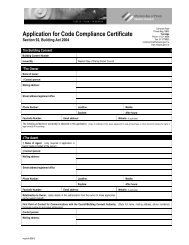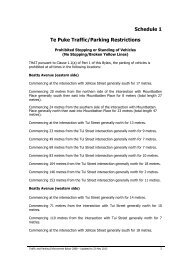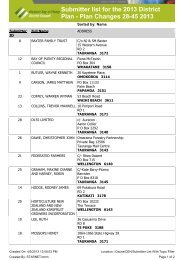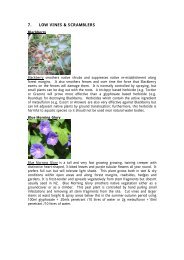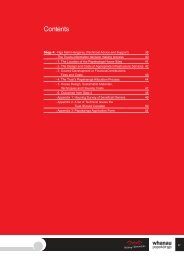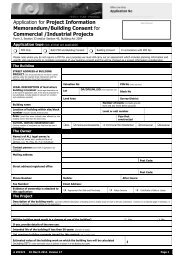Weed Control Guide - Groundcover and Creepers
Weed Control Guide - Groundcover and Creepers
Weed Control Guide - Groundcover and Creepers
Create successful ePaper yourself
Turn your PDF publications into a flip-book with our unique Google optimized e-Paper software.
8. GROUNDCOVER & CREEPERSCape IvyCape Ivy is more of a scrambling shrub than a true climber. It has thick fleshyleaves with <strong>and</strong> angular shape <strong>and</strong> thick stems <strong>and</strong> flowers abundantly in winter. Itgrows rapidly <strong>and</strong> densely covering native shrubs up to two metres tall. <strong>Control</strong> isachieved by spraying with triclopyr <strong>and</strong> penetrant, or where growth covers nativevegetation then slash to clear the ivy from the native plants <strong>and</strong> spray re-growthwithin three months.German IvyGerman Ivy is a perennial climber of the daisy family with thin ivy-like leaves onsmooth stems with small ear-like projections at base of the leaf stalks. It producesclusters of yellow daisy-like flowers from winter to spring. German Ivy is dispersedby windblown seeds <strong>and</strong> inhabits disturbed sites <strong>and</strong> forest margins, particularly incoastal areas. It can form dense infestations that can smother host species.Scattered plants can be eradicated by digging or h<strong>and</strong>-pulling, but more intensiveinfestations are most readily control by cutting away the foliage <strong>and</strong> spraying thestems with glyphosate or metsulfuron <strong>and</strong> penetrant.
NasturtiumNasturtium is a low threat plant pest which is easily controlled with glyphosate basedherbicide <strong>and</strong> a penetrant. It is a low priority for control.Tutsan (Hypericum)Tutsan is a small semi-evergreen, shrub or semi-groundcover plant that grows up to1.5 m high. It is sometimes mistaken for other weeds such as Japanese Honeysucklebut is recognised by the 5-petalled, yellow Hypericum flowers from November toFebruary followed by round red berries that ripen to black, <strong>and</strong> by its reddish semiwoodystems which have oval leaves growing in opposite pairs. The leaves arebluish-green underneath <strong>and</strong> usually turn red in autumn. Tutsan is readily seengrowing in waste areas, old gardens <strong>and</strong> roadsides <strong>and</strong> it tolerates a wide range ofenvironmental conditions. This weed thrives along disturbed bush margins,shrubl<strong>and</strong> <strong>and</strong> low-growing habitats, invading regenerating sites <strong>and</strong> forming densest<strong>and</strong>s that prevent establishment of native plant seedlings.Small plants can be controlled by digging them out <strong>and</strong> leaving them on site to rotdown. Larger plants can be cut down <strong>and</strong> stump swabbed (spring-summer only)with metsulfuron (e.g. Escort). Alternatively, infestations can be sprayed fromNovember to January with glyphosate (e.g. Roundup), or metsulfuron or triclopyr(e.g. Tordon). Whichever herbicide is used a penetrant such as Pulse must be used.The timing of herbicide application is important <strong>and</strong> follow up control will benecessary to get any plants that re-sprout from the roots or from dormant seed inthe ground.
Tradescantia (W<strong>and</strong>ering Jew or W<strong>and</strong>ering Willie)Tradescantia (W<strong>and</strong>ering Jew) is a dense matting, succulent ground cover with darkgreen, waxy leaves. It grows in a variety of light conditions but prefers semi-shadeor full shade <strong>and</strong> damp areas, finding conditions under native forest <strong>and</strong> aroundwaterways ideal. Although it doesn’t grow more that half a metre high it formsdense, smothering mats to the exclusion of native seedlings or anything else on theforest floor. Left uncontrolled it seriously impedes native forest succession <strong>and</strong>inhibits ongoing food availability for invertebrates <strong>and</strong> birds. Tradescantia is bestcontrolled by spraying with a triclopyr based herbicide (e.g. Tordon) <strong>and</strong> a wettingagent such as Pulse penetrant, or by raking <strong>and</strong> h<strong>and</strong> weeding, or by a combinationof both methods. It spreads vegetatively with any small plant fragments in groundcontact readily re-rooting so vigilance is necessary. When eradicating this weedwithout herbicide the waste must be dried <strong>and</strong> burnt or disposed of at a properl<strong>and</strong>fill but not in a greenwaste collection.



